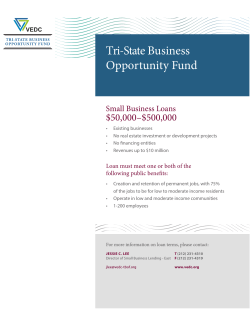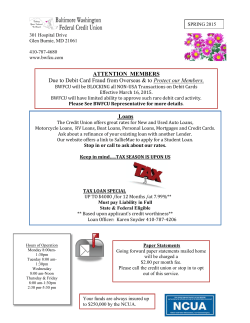
Financing Options - Johns Hopkins University Office of Financial
Johns Hopkins University Financing Options Dear Parents and Students, A quality education is an investment that will provide lifelong returns. We recognize that rising costs make paying for such an investment a major expense. The Office of What’s Next Contact Us Tips for you and your family to assist in making the cost of attending Johns Hopkins University possible. Office of Student Financial Services 146 Garland Hall / 3400 N. Charles Street Baltimore, MD 21218-2683 410-516-8028 / Fax 786-513-2839 fin_aid@jhu.edu www.jhu.edu/finaid Using the estimated cost of attendance in this brochure, review the costs with your family and begin discussing how your family will meet these expenses. Many financing options are described in this Financing Options newsletter. Considering a Parent PLUS loan? Complete the Federal Direct Parent PLUS Request Form at www.jhu.edu/finaid/elecserv/parentplus1415.pdf. Fax or mail the form to the Office of Student Financial Services. Remember that PLUS loan requests will be processed beginning in June. Keep in mind the Fall semester bills are mailed from the Office of Student Accounts in early July. Payment is due to the university in mid-August. Spring semester bills are e-mailed in December. Payment for the spring semester is due in mid-January. Research and apply for scholarships from private organizations from local, regional, and national sources. Additional information can be found at www.jhu.edu/finaid. Click on Prospective Students>Scholarships and Grants>Outside/Private. Once your JHU e-mail account has been established by the university, please check it regularly. We will use your JHU e-mail address for all correspondence. Homewood Student Accounts Office B31 Garland Hall / 3400 North Charles Street Baltimore, MD 21218-2683 410-516-8158 / Fax 410-516-4322 http://www.jhu.edu/studacct/ Student Financial Services is here to assist you in making a Johns Hopkins University education financially possible. Equal Opportunity Policy The Johns Hopkins University admits students of any race, color, gender, religion, age, national or ethnic origin, disability, marital status or veteran status to all of the rights, privileges, programs, benefits, and activities generally accorded or made available to students at the university. It does not discriminate on the basis of race, color, gender, marital status, pregnancy, ethnicity, national origin, age, disability, religion, sexual orientation, gender identity or expression, veteran status, or other legally protected characteristic in any student program or activity administered by the university, including the administration of its educational policies, admission policies, scholarship and loan programs, and athletic and other university-administered programs or in employment. Questions regarding Title VI, Title IX, and Section 504 should be referred to the Office of Institutional Equity, Wyman Park Building, Suite 515, Telephone: 410-516-8075, (TTY): 410-516-6225. As you approach the details of financing your child’s or your education, we offer some options for assistance. This brochure is provided to help you better understand what might be available. Each option may not be appropriate for every family, but we hope that in the array of possibilities you will find a method that will work best for you. Please do not hesitate to contact us or to visit our office when you are on campus. We look forward to working with you in the future. Sincerely, Tom McDermott, Director and the Staff of the Office of Student Financial Services Access Your Financial Aid Award Admitted students can access their financial aid award, if applicable, through the “Financial Aid” tab after logging in to mydecision.jhu.edu. All the information you need is located there. Current students need to access their financial aid information through ISIS , accessible once the student’s jhu.edu e-mail account has been created. Share Access Admitted students can authorize others to have access to their admissions decision website, including the financial aid award information. To do so, please log in to mydecision.jhu.edu, click on the “Share Access” tab, and follow the instructions on the screen. Please note that shared access is tied to the recipient’s e-mail address that you provide. If that person would like access to more than one admitted student’s account (e.g., your guidance counselor, or your family member if you have a sibling in the class), please e-mail us at gotojhu@jhu.edu or call 410-516-8171. Federal Direct Loan Programs The basis of a financial plan is often one or more of the federally funded and guaranteed loan programs. These include the Federal Direct Student Loan and the Federal Direct Parent Loan for Undergraduate Students (PLUS). Federal Direct Student Loans are federally guaranteed student loans. Maximum Loan Limits: Freshmen $5,500 Sophomores $6,500 Juniors $7,500 Seniors $7,500 Repayment begins six months after the student completes his/her studies or drops below half-time status. A 1.072 percent federal fee is deducted from the loan proceeds prior to disbursement. The origination fee may change depending on congressional legislation. You do not need to contact a lender since these loans are funded directly by the U.S. Department of Education. Loans can be subsidized or unsubsidized. Eligibility is determined upon receipt of the Free Application for Federal Student Aid (FAFSA) and all required supporting documents. Borrowers must electronically sign a Master Promissory Note, and loan funds are credited directly to the student’s account. Subsidized Federal Direct Loans are subsidized by the federal government and require needbased eligibility. Interest rate for 2013–2014 is fixed at 3.86 percent. Interest rate subject to change on July 1 and will be effective for 2014–2015. Interest is paid by the government until the completion of studies or the student falls below half-time status. Unsubsidized Federal Direct Loans are not need-based and are available to all students regardless of income. Interest rate for 2013–2014 is fixed at 3.86 percent. Interest rate subject to change on July 1 and will be effective for 2014–2015. Interest accrues on the loan beginning at the time of disbursement and can be paid monthly, quarterly, or capitalized upon graduation. Independent students and dependent students whose parents are denied a PLUS loan may borrow an additional unsubsidized loan above the maximum amount. Freshmen and sophomores can borrow an additional $4,000 per year while juniors and seniors can borrow an additional $5,000 per year. Federal Direct Parent PLUS Loan The Federal Direct PLUS loan is a federally guaranteed loan program available to parents of dependent undergraduate students. There is no financial need requirement to receive this loan. You do not need to contact a lender since this loan is funded directly by the U.S. Department of Education. Tuition. . . . . . . . . . . . . . . . . . . . . . . . . . . . . . . . . . . . . . . . . . . . . . . . . . . . . . . . . . . . . . . . . . . . . . . . . . . $47,060 *Room and board . . . . . . . . . . . . . . . . . . . . . . . . . . . . . . . . . . . . . . . . . . . . . . . . . . . . . . . . . . . . . . . . $14,246 Matriculation fee (freshmen only). . . . . . . . . . . . . . . . . . . . . . . . . . . . . . . . . . . . . . . . . . . . . . . . . . . . $500 Estimated Indirect Expenses Must be a U.S. citizen or permanent resident. Must be registered for the Selective Service (males only, ages 18–25). Borrower Eligibility: Must be the parent or legal guardian of an undergraduate student. Must be a U.S. citizen or permanent resident. Must not be in default on a prior student loan. Amount of Eligibility: Borrowers are eligible to request up to the full cost of attendance minus any financial aid the student receives. Borrowers apply for the amount of the PLUS loan on a yearly basis (not semester by semester). Credit Review: A credit review is required, but there is no “debt-to-income” review. A co-borrower/endorser option is offered if the borrower’s credit is denied. Credit checks are valid for 90 days. For this reason, we advise borrowers to wait until the summer before applying for the upcoming year. Processing will begin in June. Loan Terms and Disbursement: The interest rate for 2013–2014 is fixed at 6.41 percent. Interest rate subject to change on July 1 and will be effective for 2014–2015. Interest begins accruing after the first disbursement. There is a 4.288 percent origination/default fee deducted from each disbursement. The origination fee may change depending on congressional legislation. Books and supplies . . . . . . . . . . . . . . . . . . . . . . . . . . . . . . . . . . . . . . . . . . . . . . . . . . . . . . . . . . . . . . . . $1,223 **Travel expenses (average). . . . . . . . . . . . . . . . . . . . . . . . . . . . . . . . . . . . . . . . . . . . . . . . . . . . . . . . . . $650 *University room and board charges are based on type of room selected, location, and number of meals. This represents an estimate for a double room in the AMR and meal plan. **Travel expenses will depend on frequency and distance . Tuition and room and board charges for 2014–2015 have not been finalized by the board of trustees. Must not be in default on a prior student loan. (do not appear on bill) Other personal expenses . . . . . . . . . . . . . . . . . . . . . . . . . . . . . . . . . . . . . . . . . . . . . . . . . . . . . . . . . . $1,000 Student Eligibility: Must be enrolled at least half-time. Estimated Costs Estimated Billed Expenses 2014–2015 Repayment: Standard repayment begins 60 days after the loan is fully disbursed. “Fully disbursed” means that all installments (fall and spring) have been paid. Disbursements are scheduled at the beginning of each semester and are deposited directly into the student’s account. Parents may choose to defer payments up to six months after the student completes his/her studies or drops below half-time status. Interest will accrue and be capitalized quarterly. Parents may choose to pay the interest on a monthly or quarterly basis. There is no pre-payment penalty. Consolidation options and extended graduated repayment plans are available. How to Apply for a Federal Direct Plus Loan: Note: We advise borrowers to wait until the summer to apply for a Federal Direct PLUS loan. We will begin processing loans in June. 1. Complete the 2014–2015 Free Application for Federal Student Aid (FAFSA). 2. Complete and return the Parent PLUS Loan Request Form, available on our website: www.jhu.edu/finaid/elecserv. 3. New Federal Direct PLUS loan borrowers will need to sign a Master Promissory Note at the U.S. Department of Education’s direct lending website: www.studentloans.gov after the loan has been processed by our office. You will be notified when this has been done. Monthly Payment Plan A monthly payment plan may be used by parents to help meet the expected family contribution and/or pay the full cost of Johns Hopkins University with manageable monthly payments. The plan allows parents to pay up to the annual cost of tuition and room/board in 10 equal monthly installments, with payments beginning on June 1. No interest is charged, but there is an annual fee. For more information about the Tuition Management Systems (TMS) Monthly Payment Plan, go to www.jhuhomewood.afford.com or call 1-800-722-4867. Additional Scholarship Sources ROTC Scholarships. Army ROTC offers full-tuition scholarships to highly qualified students who desire to serve their country as Army officers. Contact the Department of Military Science at www.jhu.edu/rotc or by calling 410-516-4685. Air Force scholarships may also be used at JHU. Outside/Private Scholarships. Scholarships from private organizations can be a valuable source of aid. All scholarships from private organizations must be reported to Student Financial Services. Note: For the freshman year, Johns Hopkins University grants/scholarships will not be reduced if a student receives outside scholarship support unless all aid awarded exceeds the total cost of attendance. This policy does not extend into the sophomore, junior, or senior years. Outside scholarship support will then reduce Johns Hopkins University grant and need-based scholarships. More information about this policy may be found online at www.jhu.edu/finaid. Other Financing Options Home Equity. Home equity loans (or lines of credit) may be a cost-effective option for financing an education. There are many sources for these interest-deductible loans. Life Insurance. Borrowing from whole life insurance may have a lower fixed interest rate than other sources. Contact your life insurance holder for information specific to your policy. Interest on Educational Loans. Taxpayers with joint incomes below $155,000 (single filer incomes below $75,000) may deduct up to $2,500 in annual interest paid on education loans. Consult a tax adviser to determine your eligibility for tax incentives. Each year the Johns Hopkins University Tax Office will issue a 1098T to assist you with reporting tax credits and/or tax deductions on your federal tax return. This form is also accessible online at www.1098t.com. A summary of these federal tax benefits for 2013 is available on the Web at: www.irs.gov/pub/irs-pdf/p970.pdf Private Educational Loans It is highly recommended that students borrow their full federal loan eligibility before borrowing a private loan. Additional funds are available through private/ alternative loans. Each lender varies in regard to the terms, interest rate, and repayment options for their loans. Students are encouraged to carefully research private loan companies before borrowing. Loans usually have a variable interest rate based on Prime or Libor rate and on individual credit ratings. Current rates are available online at www.bankrate.com. Depending on the student’s credit history, most private loans require a creditworthy U.S. citizen co-signer. Students may borrow up to their cost of attendance minus any financial aid they receive. Students apply for the amount of the private loan on a yearly basis (not semester by semester). Repayment typically begins six months after the student completes his/her studies or drops below half-time status. For more information on private educational loans, visit www.jhu.edu/finaid. Higher Education Tax Benefits American Opportunity Credit allows a tax credit of up to $2,500 to offset the cost of tuition, fees, and textbooks. Families with joint incomes below $180,000 or single filer incomes below $90,000 are eligible. Lifetime Learning Tax Credit allows up to a $2,000 tuition tax credit. It is available to college undergraduates and graduate students. Families with joint incomes below $127,000 (single filer incomes below $63,000) are eligible. Tuition and Fees Tax Deduction is a tax deduction of up to $4,000 for qualified higher education expenses, available for taxpayers with adjusted gross incomes up to $80,000 for single filers and $160,000 for married taxpayers filing jointly.
© Copyright 2025









